Artists' Writing
Artists' Writing

Modern Love
Constance DeJong’s long-neglected 1977 novel, Modern Love, is one thing made up of many: It is science fiction. It is a detective story. It is a historical episode in the time of the Armada and the dislocation of Sephardic Jews from Spain to an eventual location in New York’s Lower East Side. It is a first-person narrator’s story; Charlotte’s story; and Roderigo’s; and Fifi Corday’s. It is a 150-year-old story about Oregon and the story of a house in Oregon. Modern Love’s continuity is made of flow and motion; like an experience, it accumulates as you read, at that moment, through successive moments, right to the end.
An important figure of downtown New York’s performance art and burgeoning media art scene in the late 1970s and early 1980s, DeJong designed Modern Love herself and published it with help from Dorothea Tanning on the short-lived Standard Editions imprint. Critically acclaimed in its time, Modern Love is now back in print on the 40th anniversary of its original publication.
Constance DeJong is an artist and writer who has worked for thirty years on narrative form within the context of avant-garde music and contemporary art. Considered one of the progenitors of media art, or “time-based media,” DeJong shapes her intricate narrative form through performances, audio installations, print texts, electronic objects, and video works. Since the 1980s, DeJong has collaborated with Phillip Glass, Tony Oursler, and the Builders Association on performances and videos at Walker Art Museum, Minneapolis, MN; the Wexner Center, Columbus, OH; Philadelphia Museum of Art; and in New York, at The Kitchen, Thread Waxing Space, the Whitney Museum of American Art, and the Dia Center for the Arts. Her books include I.T.I.L.O.E. and SpeakChamber, and her work is included in the anthologies Up is Up, But So is Down: New York’s Downtown Literary Scene, 1974–1991 (NYU Press, 2006); Blasted Allegories (New Museum/MIT, 1987); and Wild History (Tanam Press, 1985).

Top Stories
Top Stories was a prose periodical published from 1978 to 1991 by the artist Anne Turyn in Buffalo, New York, and New York City. Over the course of twenty-nine issues, it served as a pivotal platform for experimental fiction and art through single-artist issues and two anthologies. The entire run of Top Stories is collected and reproduced here across two volumes.
Top Stories primarily featured female artists, though in Turyn’s words a few men “crept in as collaborators.” Although primarily “a prose periodical” (as its byline often stated), the issues varied in form and aesthetics, pushing the boundaries of what prose could be and, from time to time, escaping the genre altogether. In fact, the only parameters required for participants were that the periodical’s logo and issue list be included on the front and back covers, respectively.
A great deal of the works are short stories by the likes of Pati Hill, Tama Janowitz, and Kathy Acker, whose Pushcart Prize–winning “New York City in 1979” appeared for the first time in book form as part of the series. Constance DeJong contributes “I.T.I.L.O.E.,” a widely unavailable work that features the artist’s trademark prose and is sure to please fans of her novel, Modern Love. The largest issue of the periodical is undoubtedly Cookie Mueller’s “How to Get Rid of Pimples,” which consists of a series of character studies of friends interspersed with photographs by David Armstrong, Nan Goldin, and Peter Hujar altered with freshly drawn blemishes.
Top Stories also celebrates less conventional literary forms. Issues by Lisa Bloomfield, Linda Neaman, and Anne Turyn take the form of artists’ books, juxtaposing image and text to construct tightly wound, interdependent narratives. Jenny Holzer and Peter Nadin present a collaborative work in copper ink comprised of truisms by Holzer on corporeal and emotional states and drawings by Nadin of abstract bodies. Janet Stein contributes a comic, while Ursule Molinaro provides a thorough index of daily life (and the contempt it produces) consisting of entries that were written just prior to lighting a cigarette.
Top Stories remains vitally defiant, an essential witness to what was the downtown literary and art-world underground.
Primary contributors include Kathy Acker, Laurie Anderson, Sheila Ascher, Douglas Blau, Lisa Bloomfield, Linda L. Cathcart, Cheryl Clarke, Susan Daitch, Constance DeJong, Jane Dickson, Judith Doyle, Lee Eiferman, Robert Fiengo, Joe Gibbons, Pati Hill, Jenny Holzer, Gary Indiana, Tama Janowitz, Suzanne Johnson, Caryl Jones-Sylvester, Mary Kelly, Judy Linn, Micki McGee, Ursule Molinaro, Cookie Mueller, Peter Nadin, Linda Neaman, Glenn O’Brien, Romaine Perin, Richard Prince, Lou Robinson, Janet Stein, Dennis Straus, Sekou Sundiata, Leslie Thornton, Kirsten Thorup, Lynne Tillman, Anne Turyn, Gail Vachon, Brian Wallis, Jane Warrick, and Donna Wyszomierski.
David Armstrong, Nan Goldin, JT Hryvniak, Peter Hujar, Nancy Linn, Trish McAdams, Linda Neaman, Marcia Resnick, Michael Sticht, and Aja Thorup all make appearances as well, contributing artwork for the covers or as illustrations.
Anne Turyn (b. 1954) is a photographer based in New York. Turyn’s work has been exhibited at the Museum of Modern Art, the Metropolitan Museum of Art, Kunsthalle Bern, Denver Art Museum, Walker Art Center, and Los Angeles County Museum of Art.
Published by Primary Information, 954 pgs, 21.6 × 14 cm, 2 Paperback books in Slipcase, 2022

Confidences / Majority
The uprising was staged by the minority, and a downfall is remembered by the majority.
Gilgamesh “Gil” Gupta is a theatre maker and self-defined “avant-gardist.” As a young vampire, Gil’s alienation from time, body, and identity only increases with the murder of his sire, Patrice. Seasons pass in spite of this, and Gil endeavours to circumvent inter-species edicts to foster a meaningful audience. Recognition becomes a vocation.
Confidences / Majority is a novel that presents entertainment as critical gospel. Seething a trail of cultural debris, Majority is the second instalment in Ivan Cheng’s Confidences series, which deploys a version of the vampire and performance as sites for transformation and maintenance.
Ivan Cheng (b. 1991, Sydney) produces films, objects, paintings and publications as anchors for the staging of complex and precarious spectacles. His background as a performer and musician form the basis for his using performance as a critical medium and questioning publics and accessibility. He holds an MFA in Critical Studies from Sandberg Instituut; his work has recently been presented at Voiture14 (Marseille), La Maison Pop (Montreuil), Les Urbaines (Lausanne), Volksbühne Roter Salon (Berlin), Oude Kerk (Amsterdam), Belvedere21 (Vienna), MuHKA (Antwerp), Carriageworks (Sydney), Federation Square (Melbourne). In 2017 he initiated the project space bologna.cc in Amsterdam.
Confidences / Majority is published simultaneous to Cheng’s solo presentation Milieu at Édouard Montassut, Paris.

Hunters Follow Harpy Shadows
Hunters Follow Harpy Shadows is an experimental work featuring a series of poetic writings that explore fantasy narratives of rewritten mythologies. Mixing re-imagined trans Korean folklore, queered Biblical storytelling and pirate lore, the publication is an amalgamation of writing delivered from the lips of the artist as a genderfluid seraphim that has left heaven to tell mortals of the other worlds.
Across twenty-five chapters, Rin Kim’s text recounts the tangled, cosmic history of shapeshifting goddexes intermixed with an otherworldly cast of demis, dryads, wraiths, satyrs, tieflings and sirens. Taking cues from the Old Testament, fantasy storytelling, and the depths of fanfiction forums online, the project alternates between narrative storytelling in the direct mode of epic religious texts and a series of Psalmic interventions spoken in the innermost voice of the gods. Like a series of connected visions, Hunters Follow Harpy Shadows hands down the origin stories of distant worlds — of clashing immortals, species dying out, and deities fading from power. It is both a fantasy saga beset by violence, warfare and blood sacrifice, and a lovers’ song of longing and transcendence.
During the origins of the earth, mortals sacrificed their children to the belly of the depths, to Yawong: god of subservience and singularity…
Central to the project are new images by Oliver Davis, shot on 35mm film, which offer views of a fragmented landscape — jewel-like glimpses of sunlit trees, river stones, and murky underbrush. The lush world seen in these photographs, a version of earth devoid of all humans and figures, provides a quiet space outside of time for staging the mythic struggles of the gods. The book’s typography suggests perhaps an ancient document or illustrated manuscript; the sharp, secret lettering carrying the magic properties of a blade used to split worlds.
Design: Rin Kim
Photography: Oliver Davis
Editing: Olivia Ross
Production: The Uses of Literacy
Cloth-bound hardcover (Feincanvas), with cover tip-in and metallic foil stamping
Rin Kim, born in 1997 in Watertown, New York; is a multi-diciplinary trans chimera, demi, hydra, mutt, graphic designer, filmmaker, alchemist, performance artist, writer, and yong working around non-binary mythologies, ritual storytelling, and fantasy. Their work is a hyperfocused movement of a particular upheaval, an ongoing irruption that re-arranges every assumption of the equivalence of subjectivity and identity.

Responses to Derek Jarman’s Blue
Responses to Derek Jarman's Blue is the third publication in a series of anthologies from Pilot Press seeking contemporary responses to works of art made during the AIDS crisis.
In this third iteration, responses were sought to the 1993 film Blue by the multidisciplinary artist Derek Jarman.
Contributors
In order of appearance
Roelof Bakker
Jared Davis
Becca Albee
Linda Kemp
Ashleigh A. Allen
David Nash
Sam Moore
Anton Stuebner
Gonçalo Lamas
Olivia Laing
Nate Lippens
Jason Lipeles
JP Seabright
Andrew Cummings
Sig Olson
Maria Sledmere
Cleo Henry
Jessie McClaughlin
Lars Meijer
Scott Treleaven
Declan Wiffen
Caitlin Merrett King
Harry Agius
António Manso Preto
Adriana Lazarova
Brooke Palmieri
D Mortimer
Mary Manning
Aaron James Murphy
Printed on 100% recycled paper
Published by Pilot Press, 20 × 15 cm, Softcover, 2022

Bricks from the Kiln — Issue 4: On Translation, Transmission & Transposition
Andrew Walsh‐Lister, Matthew Stuart and 2 more
Bricks from the Kiln is an irregular journal edited by Andrew Lister and Matthew Stuart, sometimes with guest editors, that presents graphic design and typography as disciplines activated by and through other disciplines and lenses such as language, archives, collage, and more. It borrows its title from the glossary notes of Ret Marut’s "Der Ziegelbrenner," which was the ‘size, shape and colour of a brick’, and ran for 13 issues between 1917 and 1921.
The latest installment, "#4: On Translation, Transmission & Transposition," was published as an event (and now) a publication, with events at London College of Communication, Burley Fisher Books & Pig Rock bothy, Socttish National Gallery of Modern Art, and Inga (in November, 2019).
GREENING
Helen Marten
(front / back flaps)
JOY & HAPPINESS, FIDELITY
& INTIMACY IN TRANSLATION
Sophie Collins
(pp.4–13)
PLANETARY TRANSLATION
Don Mee Choi
(pp.15–19)
TRANSLATION AND A LIPOGRAM:
OR, ON FORMS OF AGAIN-WRITING
AND NO- (OR NOT THAT-) WRITING
Kate Briggs
(pp.23–33)
UNHOMING (1 of 4):
FOLLOWING HÖLDERLIN’S ‘HEIMAT’
Phil Baber
(pp.35–47)
SNOW WHITE AND THE WHITE
OF THE HUMAN EYEBALLS
Joyce Dixon
(pp.51–62)
ALTAMIRALTAMIRALTAMIRA
Florian Roithmayr
(pp.65–116)
LEVEL UP, LEVEL DOWN
Jen Calleja
(pp.119–124)
TRANS.MISSION [A.DIALOGUE]:
A JAVASCRIPT FOR THREE VOICES
J.R. Carpenter
(pp.127–134)
THE MECHANISATION OF ART
Edgar Wind
(glosses / annotations / insertions by
Natalie Ferris & Bryony Quinn)
(pp.137–144)
UNHOMING (2 of 4)
Phil Baber
(p.147)
COMMISSION FOR A NOIR MOVIE
B IN THE BAY OF BISCAY
Rebecca Collins
(pp.151–157)
UNHOMING (3 of 4)
Phil Baber
(pp.150–162)
EVERY CONTACT LEAVES A TRACE;
TRANSCRIBING OSTEON
Naomi Pearce
(pp.165–170)
HOW DOES A WORK END?
Karen Di Franco
(pp.173–193)
METONYMY Op.1 & Op.2
James Bulley
(pp.197–201)
AFRIKAN ALPHABETS EXTENDED
Saki Mafundikwa
(pp.204–207)
SUSAN HILLER: 1983
Natalie Ferris
(pp.209–217)
EVERY TELLING HAS A TALING /
EVERY STORY HAS AN ENDING
Matthew Stuart
(pp.220–233)
GRAPHIC PROPRIOCEPTION
James Langdon
(pp.235–254)
UNHOMING (4 of 4)
Phil Baber
(pp.257–263)
TUNNELLING AND AGGREGATING
FOR DESIGN RESEARCH
Bryony Quinn (text) &
Peter Nencini (images)
(pp.265–272)
LET IT PERCOLATE:
A MANIFESTO FOR READING
Sophie Seita
(pp.275–280)
288 pgs, 22.4 × 17 cm, Softcover, 2020

How to love a homeland
Russian writer and philosopher Oxana Timofeeva was born and grew up in various parts of the USSR. The book explores the difficulty of reducing one’s sense of homeland to one’s country alone, the philosophical interconnectedness of movement and rootedness, our plant and animal souls, and how we need to reimagine our desired, fictional if need be, homelands. The book interweaves vignettes from Timofeeva’s childhood across different parts of the USSR with a philosophical discussion of ideas on homeland in the thought of Brecht, Deleuze and Guattari, and other main figures of literature and philosophy.
Oxana Timofeeva is Sc.D., professor at “Stasis” Center for Philosophy at the European University at St. Petersburg, leading researcher at Tyumen State University, member of the artistic collective “Chto Delat” (“What is to be done”), deputy editor of the journal “Stasis”, and the author of books History of Animals (London: Bloomsbury Academic, 2018; Maastricht: Jan van Eyck, 2012), Introduction to the Erotic Philosophy of Georges Bataille (Moscow: New Literary Observer, 2009), Solar Politics(forthcoming, Polity, 2022).
Commissioned and published by Kayfa ta (2020)
Translation from Russian by Maria Afanasyeva
Design template by Julie Peeters
Cover illustration by Jumana Emil Abboud

How to remember your dreams
The book is a sharp and creative reflection on the interweaving of personal and national/ideological dreams. The chapters are on facts and fictions created in both, how one retraces one’s way through them, and through the numerous philosophers/thinkers/ideas (from Sartre to Zizek, Abdel-Nasser to Ibn Taymiya and others) that appear and shape his life journey, studies and dreams.
Amr Ezzat is an Egyptian writer who studied engineering and philosophy. He worked as an engineer and then a journalist before becoming a human rights researcher and a writer for numerous newspapers and other periodicals. He remembers his dreams very well.
Commissioned and published by Kayfa ta in 2019, printed in Beirut in 2021
Translated from English by Jennifer Peterson
Design template by Julie Peeters
Cover illustration by Hany Rashed

How to spell the fight
James R. Murphy, a math teacher in La Guardia, New York, regarded mathematics as the most powerful and manipulable abstract language available to humans. To acquaint students who don’t “like” math with abstract and systematical thinking, he put a piece of string in their hands and taught them to make string figures.
How to spell the fight follows a thread that has been running through our fingers from centuries past till the present day, morphing from the tangible string figures that join our hands in childhood to the more elusive computational algorithms that engage our fingers today. Following this line of inquiry through various twists and turns, a conversation about collective agency emerges with the aim of rethinking current paradigms of cognition, education, and power.
Natascha Sadr Haghighian is an artist living in Berlin. Her research-based practice encompasses a variety of forms and formats, among them video, performance, installations, text, and sound. She tries to learn how to make string figures.
Text: Natascha Sadr Haghighian
Commissioning editors: Maha Maamoun and Ala Younis
Copyeditor: Ryan Inouye
Co-publishers: Kayfa ta, Sternberg Press, and Tanmia Bookstores
Design template: Julie Peeters
Size: 9.6 x 14.8 cm
Pages: 80 pages, Soft cover
Printed in Cairo.
![Cover of OEI #94-95 Geografier [Geographies]](https://rile.space/storage/1488/0216_Scan2022-04-15_140650_004.jpg)
OEI #94-95 Geografier [Geographies]
Jonas J. Magnusson, Cecilia Grönberg and 1 more
The new publication triangulates between geopoetics, geopolitics, and cultural geography; a 464 page issue with some 50 contributors as well as a large section on Swedish philosophical geographer Gunnar Olsson.
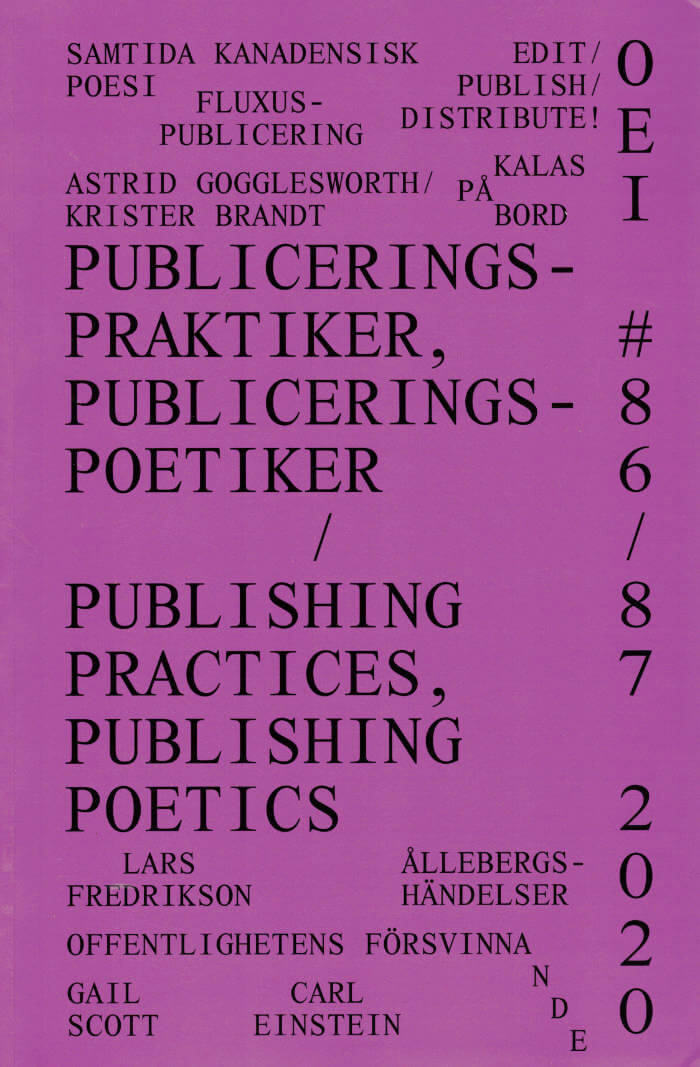
OEI #86/87 Publishing Practices, Publishing Poetics
Tobi Maier, Cecilia Grönberg and 1 more
Once more, an astonishing issue of OEI – a thrilling, compelling, stimulating feast of ideas regarding publishing and the book: the perfect big companion to read and hug in bed while the virus spreads outside.
Bringing together contributions from circa 130 publishing structures, publishing communities, magazines, small press endeavors, artists, poets, writers, editors, theoreticians, curators, scholars, and art bookstores, OEI # 86–87 reflects upon the challenges, pressures and possibilities of publishing and creating publics in different contexts and places in a time of far-reaching – economical, medial, political, social, technological – transformations.
The potential and the versatility of publishing open it to a diversity of practices and approaches in the arts, but as an eminently social form of art, a collective or micro-collective work with shared responsibilities, it is also a never-ending process of “crafting a variegated approach to how you create, publish, distribute, and build a social ecosystem around your efforts”, of trying to “build up and strengthen the community around these printed forms” (Temporary Services).
It is the conviction of OEI #86–87 that print has the power to play an important part in the construction of social spaces, of a social world. As Benjamin Thorel puts it in one of the essays in the issue, “conceiving of the dynamics of publishing as making publics as well as making things public is not a pun – insofar as the artists/publishers encompass, beyond the book itself, its possible ‘lives’, imagining the different spaces, and the different people, amongst whom a publication will circulate.” This is what Michael Warner has called “a public [as] poetic worldmaking”, implying “that all discourse or performance addressed to a public must characterize the world in which it attempts to circulate, projecting for that world a concrete and livable shape, and attempting to realize that world through address.”
This is also, as stressed by Annette Gilbert and others, what can make publishing such an active force, a force co-constituting texts and publications and publics. Indeed, with Michalis Pichler, it is tempting to say that in publishing as practice – perhaps more than in any other art field – “artists have been able to assert the aesthetic value of their own socio-politically informed concerns and to engage, often under precarious conditions, in cultural activities fully aligned with their political values.”
OEI #86–87 also includes sections on and with contemporary poetry from Canada; Fluxus publishing; Krister Brandt/Astrid Gogglesworth; Kalas på BORD (Öyvind Fahlström); Lars Fredrikson; Claude Royet-Journoud’s poetry magazines; Carl Einstein; Gail Scott; Ållebergshändelser; OEI #79: edit/publish/distribute!; “det offentligas försvinnande” and many many other things. [publisher’s note]
Design by Konst & Teknik

OEI #82-83 Art in the Age of Kleptomania
Jonas J. Magnusson, Cecilia Grönberg and 1 more
Aeron Bergman and Alejandra Salinas, co-editors at INCA Press (along with Irena Borić), are the guest-editors of this issue of OEI: it contains essays, artworks, and archival materials by 21 artists, theorists, writers, and artist-run spaces (mostly from the Americas).
The subject of the issue is art and neoliberalism, and it encompasses essays, images and other works by Dorothée Dupuis, Max Jorge Hindered Cruz, Luciano Concheiro, Yvonne Osei, Diego Bruno, John Riepenhoff, Suhail Malik, Good Weather, The Luminary, Bikini Wax, Beta-Local and more.
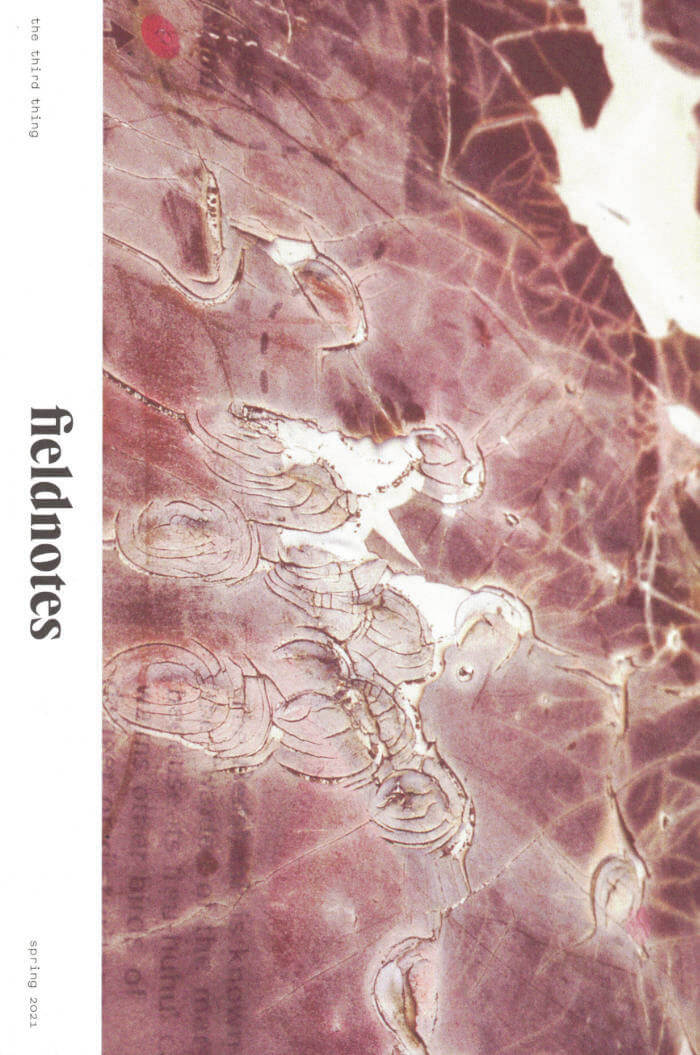
Fieldnotes Issue 1
The first issue of Fieldnotes contains work by:
Lauren Berlant & Kathleen Stewart
Wytske van Keulen
Zara Joan Miller
Estelle Hoy
Rob Halpern
Ana Vaz & Ben Rivers
Matthias Connor
Wythe Marschall
Sarah Mangold
Patrick Keiller
Helen Marten
Lulu Wolf
Emily Hunt Kivel
Amparo Dávila trans. Audrey Harris & Matthew Gleeson
Ulrike Almut Sandig trans. Karen Leeder
Malcolm Bradley & Juliette Pépin
David Manley
Eloise Lawson

Fieldnotes Issue 3
Fieldnotes is a biannual print journal publishing new writing and artworks with a focus on practices that work between disciplines and against type. There is always a third thing between two things that are known; we are interested in whatever there is between translations/transitions, things-in-progress, converging genres, methods of excavation and formal innovation. The purpose of the journal is to provide a test site for ideas and research; a space for experimental modes and new prototypes.
The third issue of FIELDNOTES contains new work by:
CAConrad & George Finlay Ramsay
Charlie Hawksfield
Yvonne
Angus McCrum
Peter Gizzi
McKenzie Wark
Kate Paul
Michelle Williams Gamaker
Georges Bataille & Rachelle Rahmé
Declan Wiffen
Rosa Barba
Travis Jeppesen
Robert Glück & Arnold Kemp
Cecilia Pavón & Jacob Steinberg
George Lynch
Yuhan Shen
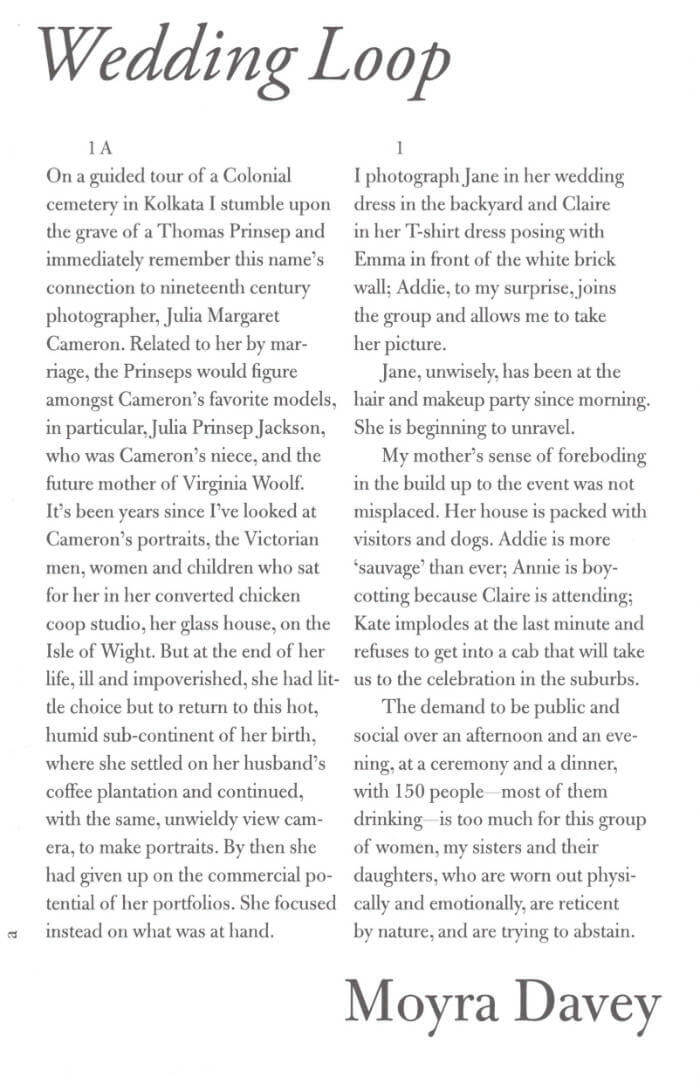
Wedding Loop
Edition on Moyra Davey's film Wedding loop, in which a wedding party is being reflected through the work of 19th-century photographer Julia Margaret Cameron.
Design by Will Holder
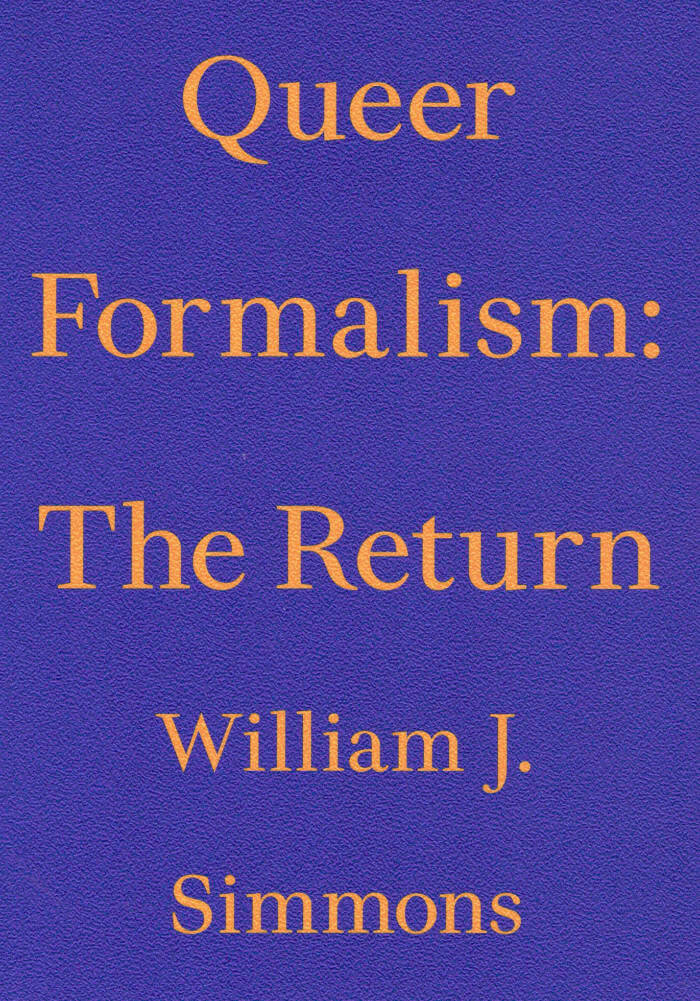
Queer Formalism: The Return
A new kind of queer art writing.
Queer Formalism: The Return expands upon William J. Simmons's original, influential essay “Notes on Queer Formalism” from 2013, offering novel ways of thinking about queer-feminist art outside of the critical-complicit and abstract-representational binaries that continue to haunt contemporary queer art. It therefore proposes a new kind of queer art writing, one that skirts the limits imposed by normative histories of art and film.
Artists addressed in Queer Formalism: The Return include: Sally Mann, David Lynch, Lars von Trier, Math Bass, Lorna Simpson, Laurie Simmons, Alex Prager, Lana Del Rey, Jessica Lange, and Louise Lawler, among others.

rosa rosa rosae rosae
Produced in conjunction with the exhibition that took place at Maison Pelgrims (10/9-23/10/2021), the book presents original interventions by the artists of the rosa rosae rosae project : Alicia Jeannin, Alicja Melzacka, Angela Detanico & Rafael Lain, Annaïk Lou Pitteloud, Audrey Cottin, buren, Charlie Usher, Eleanor Ivory Weber, Eva Giolo, Henry Andersen, Jan Vercruysse, Maíra Dietrich, Marc Buchy, Maxime Jean-Baptiste, Niels Poiz, Oriol Vilanova, Sabir (Lucie Guien, Amélie Derlon Cordina, Sophie Sénécaut / Perrine Estienne, Kevin Senant, Maud Marique, Pauline Allié, Carole Louis), Slow Reading Club, Sofia Caesar, Surya Ibrahim, Yiannis Papadopoulos, Yoann Van Parys
Edited by Pauline Hatzigeorgiou / SB34
Graphic design by Tipode Office
The book was produced with the support of Fédération Wallonie-Bruxelles (aide à l'édition) and Région Bruxelles-Capitale (Image de Bruxelles)
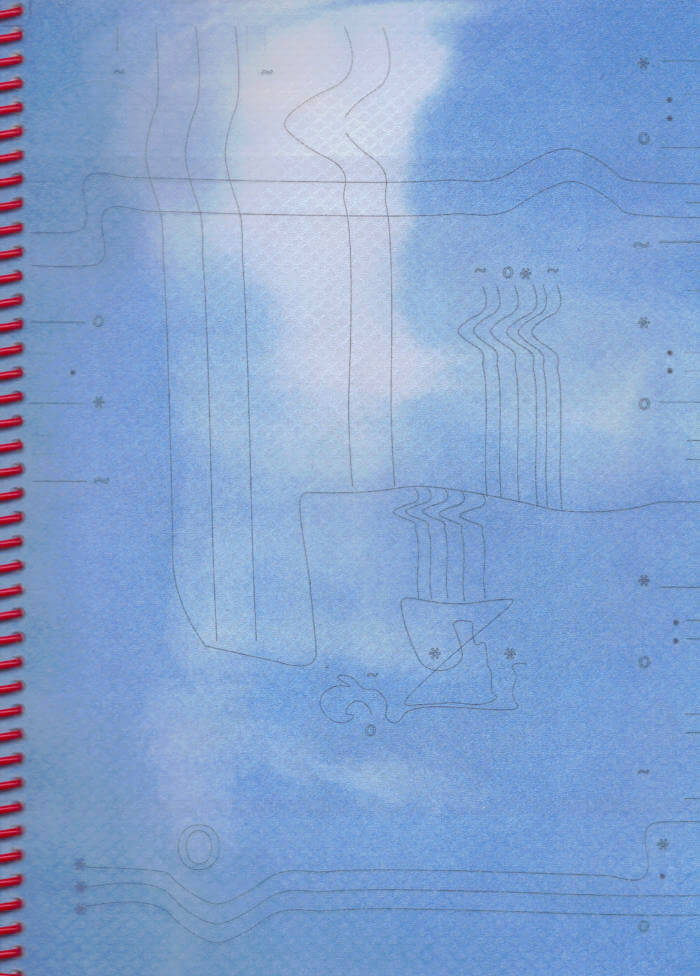
Under the Rainbow - Over the Weather
Speculative fiction magazine with contributions by 16 international (comic)artists/ writers/ designers/ curators/ witches. Exploring the world in the 4th millennium through images, words and dreamscapes.
Plastic coil bound with plastic covers.
Transparent cover with “A Short Manifesto” by Dutch conceptual artist Stanley Brouwn.
48 fold out pages, 185x262mm (foldes out to 185x365)
Riso printed on 100gr Munken Lynx by Hocus Bogus Publishing
Edition of 150
Cover design by Finn Melvin Caird
Design, layout and proofread by Yahaira Brito Morfe
Edited, printed and bound by Dennis Muñoz Espadiña
Language: English

Writing in Space, 1973–2019
Writing in Space, 1973-2019 gathers the writings of conceptual artist Lorraine O'Grady, who for over forty years has investigated the complicated relationship between text and image.
A firsthand account of O'Grady's wide-ranging practice, this volume contains statements, scripts, and previously unpublished notes charting the development of her performance work and conceptual photography; her art and music criticism that appeared in the Village Voice and Artforum; critical and theoretical essays on art and culture, including her classic "Olympia's Maid"; and interviews in which O'Grady maps, expands, and complicates the intellectual terrain of her work. She examines issues ranging from black female subjectivity to diaspora and race and representation in contemporary art, exploring both their personal and their institutional implications.
O'Grady's writings—introduced in this collection by critic and curator Aruna D'Souza—offer a unique window into her artistic and intellectual evolution while consistently plumbing the political possibilities of art.
Edited by Aruna D'Souza

Bookmarks of sorts
Afternoon Editions no. 5: a collection of found papers annotated by Jeroen Peeters, titled Bookmarks of sorts. During several years Jeroen Peeters collected notes left by readers in library books: faded reader tickets, scraps with notes, a shopping list, train tickets and other little papers used as bookmarks. He noted each time the date and the book in which they were found. Afterwards he wrote commentaries to this collection, an essay on alternative reading practices, marginalia and extra-illustration, on the exchange between readers and the imaginary community lingering in all those library books.

Weaknesses
Afternoon Editions no. 2: text and drawings by Chrysa Parkinson titled Weaknesses. Between January and March 2019 Time has fallen asleep in the afternoon sunshine was presented as a solo-exhibition at Index Foundation in Stockholm. During this period Chrysa Parkinson was invited as a guest writer for Afternoon Editions. Weaknesses is a leap in memory.

On the Self-Reflexive Page II
Originally published in 2010, ‘On the Self-Reflexive Page’ is part artist’s book and part essay, part literary excavation and part typographical miscellany. For this second incarnation of Louis Lüthi’s anthology of thematically arranged pages, the original material has been significantly expanded and revised. Like its predecessor, the new version proposes a typology of nonverbal elements found in novels, short stories, and essays. In each of the pages reproduced here, the prose is interrupted by one of these nonverbal elements, from black or blank pages, drawings or collages, photographs or film stills, to fragments of text or visual poems that are distinct from a conventional page layout.
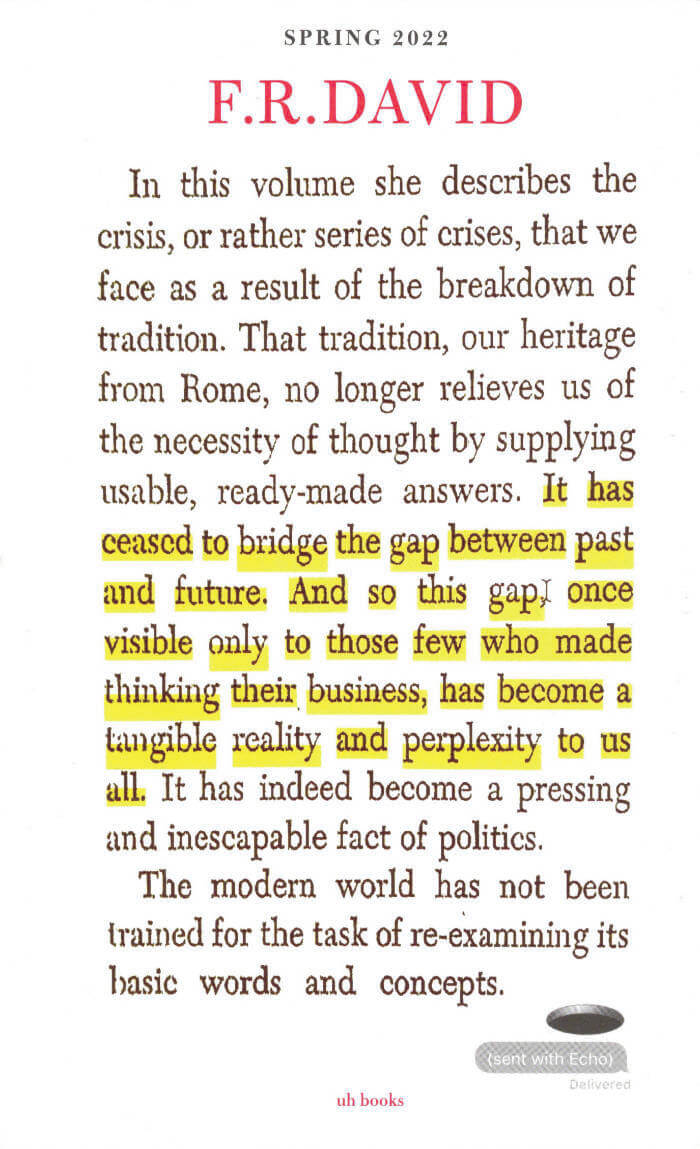
F.R. David - "Take, Eat"
Will Holder, Andrea di Serego Alighieri
F.R.DAVID is a typographical journal, dealing with the organisation of reading and writing in contemporary art practises.
The 21st issue, “Take, Eat” is edited by Will Holder, with Andrea di Serego Alighieri. Andrea’s image-heavy talk on word spacing and vocalisation runs all the way through, on the right-hand pages: the opposite pages contain responses from Will. The issue almost stifles the triangulated space of image, context and commentary; and speaks of the moment between words, things, people, images, perception, past, present and future, between Andrea’s pages and Will’s, as where meaning might breathe.
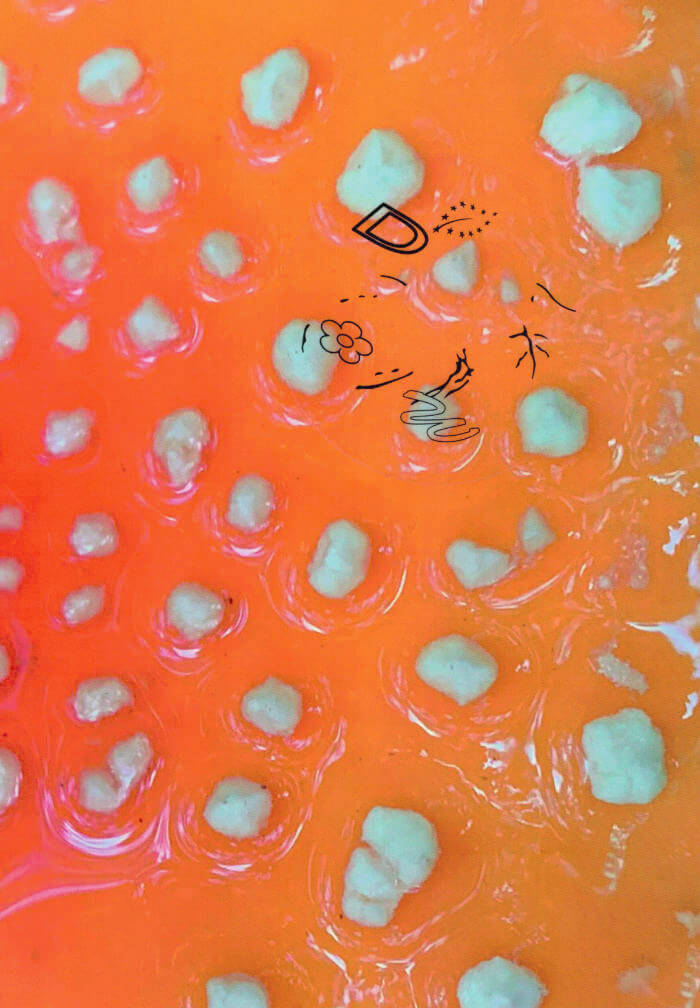
DAISYWORLD MAGAZINE #3
ROT, LANGUAGE & A STRAY BUTTERFLY
CONTRIBUTORS Eady van Acker, Anouk Asselineau & Myrto Vratsanou, Britt Browne, Finca Tierra Negra, Yuri Hasegawa, Celine Caly, Aimilia Efthimiou & Comfy Shrooms, Paige Emery, Elizaveta Federmesser, Edwin Godínez, Meg Hadfield, Freya Häberlein, Johanna Hedva, Zsófia Jakab, Lijuan Klassen, Marijn van der Leeuw, Juliette Lizotte, Niklaus Mettler & Anja Wille-Schori, Hatty Nestor, Kamila Sipika, Zazie Stevens & Alex Valentina.
DAISYWORLD MAGAZINE is a seasonal art publication on perception, the sensory, the non-human, ecology & erotica with an emphasis on interconnectedness. The artist's intimate knowledge based on observation, questioning anthropocentrism through beauty & language. Reflecting on the past season while softly moving into the next, each issue launches in-between seasons; appreciating experience, transition, and metamorphosis instead of anticipating the next big thing
Cover image: Zazie Stevens